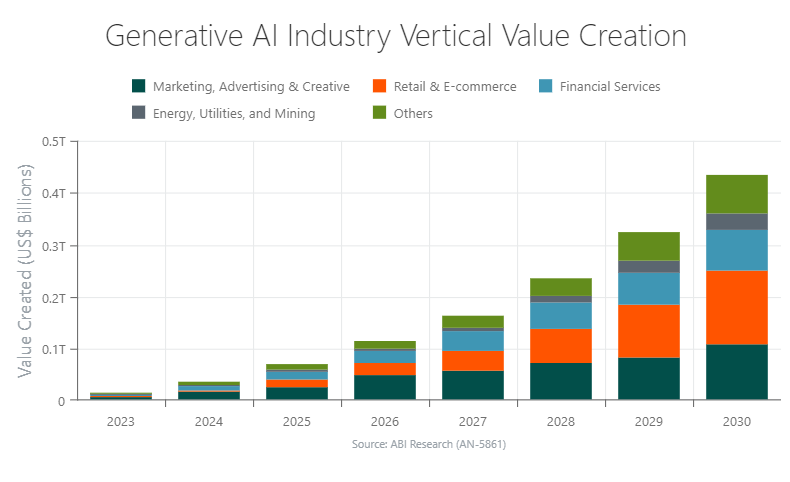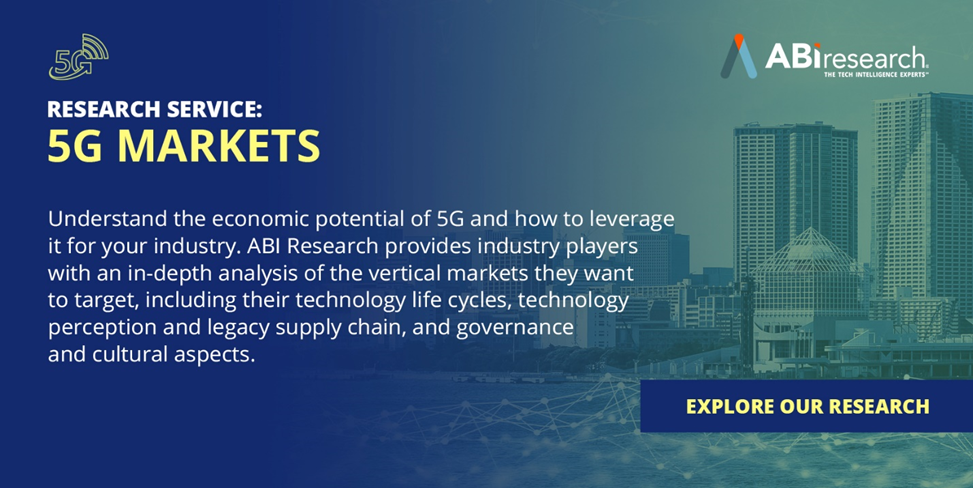Generative Artificial Intelligence (AI) has been one of the most popular technology topics of 2023. The hype for generative AI is justified, promising enterprises huge leaps in productivity if implemented correctly. While most enterprises are still years away from company-wide adoption, some early movers are showing huge progress, with most having at least placed generative AI on their radar with plans to adopt it. ABI Research’s Generative AI Business Outcomes: Identifying Enterprise Commercial Opportunities report provides a full-fledged evaluation of generative AI, including business use cases, challenges to implementation, market trends, and strategic recommendations. Here are five of the biggest trends from our research report that you should know about.
Table of Contents
- Trend #1: Generative AI Adoption Will Add More than US$450 Billion to Enterprises by 2030
- Trend #2: Enterprises Need a Corporate Strategy before Implementing Generative AI
- Trend #3: Company Size Influences Generative AI Approaches
- Trend #2: Generative AI Use Cases Will Manifest at Different Times
- Trend #5: A Strong Regulatory Framework Is Needed, but So Far, These Are Few and Far Between
What Is Generative AI?
Generative AI is an advanced form of Artificial Intelligence (AI) that uses models and algorithms to produce outputs that include videos, images, text, code, 3D content, and data. Deep Learning (DL) models are trained on a specific set of data to develop weights and biases that generate outputs.
As a basic example, ChatGPT was trained on 570 Gigabytes (GB) of data scoured over the web, including books, articles, web text, and other informational content published online. ChatGPT generates text-based prompts based on relevant sources from all that content. From the enterprise perspective, this has significant value as generative AI models can be trained for specific industry verticals or even companies using curated datasets. This facilitates applications like a chatbot tailored to provide advice to industrial engineer designers in real time or enabling pharmaceutical companies to accelerate drug discovery by analyzing molecule and protein data.
While generative AI is not a new technology, its use in consumer applications like ChatGPT has led to its widespread popularization. However, the enterprise segment is the next inflection point for generative AI, as organizations worldwide aim to bolster productivity, create new services, and support process automation.
Next, let’s assess some of the major trends that our research report reveals about enterprise generative AI.
Below is the quick video version recapping the trends.
Trend #1: Generative AI Adoption Will Add More than US$450 Billion to Enterprises by 2030
Enterprise interest in generative AI software is so significant that ABI Research expects it to add more than US$450 billion in value across 12 verticals by 2030. Generative AI will be used differently in each industry, with retail and e-commerce being the biggest beneficiaries of adopting the technology. The value of generative AI in business contexts stems from enormous productivity gains, accelerated time to market for new products/services, and improved customer service.

Trend #2: Enterprises Need a Corporate Strategy before Implementing Generative AI
Enterprises must have a well-defined corporate strategy for generative AI, encompassing governance, legal considerations, employee guidelines, and specific business outcomes. A widescale adoption of generative AI will entail a colossal change in company culture and processes, for which most enterprises are not prepared. Enterprises adopting generative AI without a clear corporate strategy risk internal fragmentation and a poor transition. Some key factors to account for in a generative AI corporate strategy include:
- Approach to Application Programming Interface (API) models
- Corporate approach to using Large Language Models (LLMs) in business processes.
- Identifying the best use cases for generative AI in your operations.
- Determining what information can be trusted to use for prompt applications.
- Deciding which guardrails/content security features will be leveraged.
- Choosing where generative AI models will be deployed (e.g., on-premises, virtual private cloud, third-party data centers).
Trend #3: Company Size Influences Generative AI Approaches
Multinational Corporations (MNCs), Small and Medium Enterprises (SMEs), and startups are all approaching generative AI differently due to varying degrees of access to capital, internal skillset, and different pain points.
- MNCs are highly concerned with security vulnerabilities, slowing generative AI's growth. We’re seeing MNCs partnering with mainstream vendors to deploy Proofs of Concept (PoCs) in on-premises walled gardens.
- SMEs are also still in this exploratory phase with generative AI. Some SMEs use low/no-code platforms like Amazon Bedrock; however, security concerns, operational complexity, and prohibitively high costs are holding back adoption among SMEs.
- Startups, which are on the other end of the spectrum, are keen to adopt generative AI as quickly as possible to create brand differentiation. However, these LLMs are not as finely tuned as what MNCs are developing, which are more relevant to specific use cases/industries.
Did you miss our Generative AI in Manufacturing: Transformative Technology or Potential Problem? webinar? No problem - Watch the replay!
Trend #4: Generative AI Use Cases Will Manifest at Different Times
While the list of use cases for generative AI is extensive, they will not materialize simultaneously. ABI Research sees the Business-to-Business (B2B) market adopting generative AI in three distinct phases:
- Employee Augmentation: Content generation, chatbots, and research support will be facilitated in the first wave, having a large impact on creative, entertainment, retail, and education verticals.
- Service Enablement: Enterprises will increasingly be able to use generative AI to build services for clients and support more complex employee processes like risk management and product lifecycle management.
- Process Automation: Process automation, predictive maintenance, and system optimization will have massive implications for each vertical, especially for the manufacturing, transport & logistics, industry, and energy sectors.
Trend #5: A Strong Regulatory Framework Is Needed, but So Far, These Are Few and Far Between
One of the biggest roadblocks to the mass adoption of enterprise generative AI is the question mark surrounding the security of the technology. Understandably, enterprises are worried that generative AI outputs could be inaccurate or untrustworthy, leading to poor business outcomes. Moreover, companies are wary of copyright infringement, Intellectual Property (IP) theft, and other data privacy concerns. Adding to this, there is still some confusion about the legality of using third-party content.
The generative AI industry must adopt strong regulatory frameworks that mandate guardrails, watermarks, and other strategies to overcome these security barriers. Governments have been expected to lead this process and develop symmetrical, centralized regulatory frameworks, but so far, different countries have shown varied approaches creating additional risk within the market.
Generative AI Is Ready for Primetime, but Challenges Still Hinder Adoption
Generative Pretrained Transformer (GPT) applications like ChatGPT (an OpenAI chatbot based on GPT-3) have already taken the consumer markets by storm. Over the next few years, we expect more widespread adoption of generative AI applications like these in the enterprise domain. From a business standpoint, the value of generative AI is clear from product time to market to process and service automation.
Currently, generative AI is primarily reserved for low-risk use cases and PoCs, signaling how wary enterprises still are about the technology’s maturity and accessibility. Before generative AI transforms the modern enterprise, privacy, ethical, and legal issues must be properly addressed. Moreover, enterprises still lack the strong corporate strategy required to implement generative AI company-wide.
Assess all the latest trends within the world of generative AI by checking out ABI Research’s Generative AI Research Spotlight.






